This weekend I managed to “catch” my 143rd unique pokémon in the game Pokémon Go. Currently it is possible to catch 145 different pokémon, but four of them are regional and I’ve only been to two of the regions. This means that I have caught all of the ones it has been possible for me to catch.
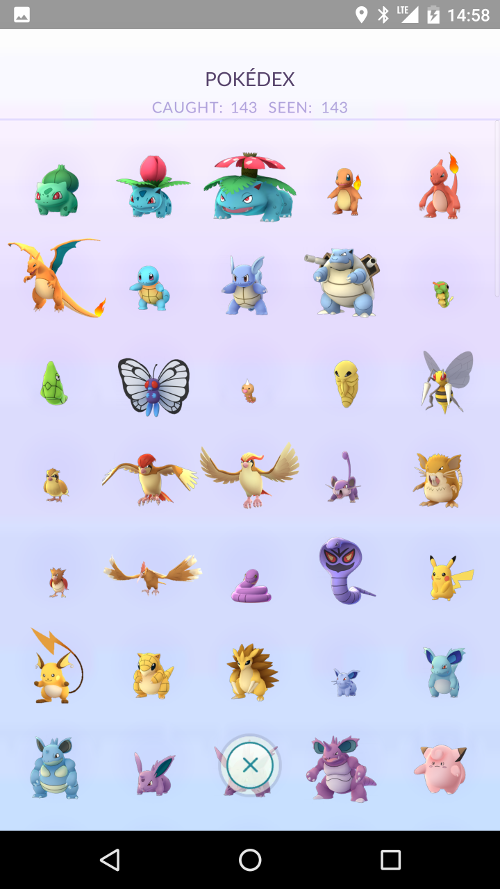
As a player of Niantic’s other game, Ingress, I thought I’d write up a review of Pokémon Go but from the perspective of an Ingress player.
I’ve written about Ingress before so I won’t go into detail, but the easiest way to sum it up is that it is a geo-location “capture the flag” game played on mobile devices. Players are on either the green “Enlightened” team or the blue “Resistance” team and the object is to physically move from place to place to visit locations called “portals”. Using items found in-game, players can control the portals for their team and points are scored for the amount of control a given team has over the playing field, which happens to be the planet Earth.
It can get quite addictive, so when Pokémon Go came out I had decided to pass, as the last thing I needed was another time sink like Ingress. However, Andrea started playing so I did as well. There are many different aspects to the game, but the part I liked was trying to catch all of the different types of pokémon. My OCD kicked in and I was determined to do it even though the game became kind of boring, and now that I’ve done it (well, to my satisfaction) I don’t really have the desire to play it much more.
Pokémon Go shares a lot with Ingress. For example, both require you to move around to different locations, and the locations in Pokémon Go happen to correspond to the portal locations in Ingress. But they differ in a lot of important ways.
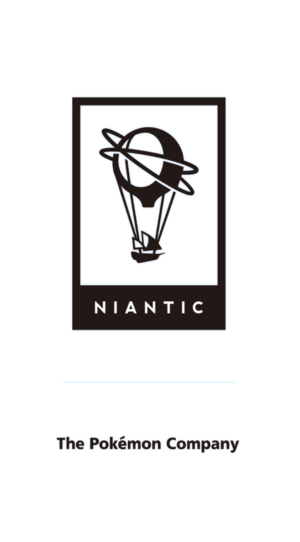
Pokémon Go is a joint venture between Niantic Labs and The Pokémon Company, although I think the opening splash screen can be misleading since it looks like Niantic is The Pokémon Company. When I first heard about the game, the partnership made sense, since Pokémon has this huge legacy and backstory that fits well with Niantic’s tech.
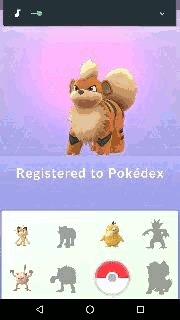
In a nutshell, the goal of Pokémon Go is to catch “pokémon”, or little monsters. You do this by finding them in the “real world” by walking around and they will then appear in the application. You then throw a “Poké Ball” at them, and if you aim well, you have a chance to trap the pokémon in the ball and they get added to your collection. Catching a unique pokémon will add an entry into your “Pokédex” and one of the goals is to catch one of every type. Various actions let you earn “experience points” (XP) and the more experience you have, the more powerful the ‘mon you encounter and the more items you can use (both you and your ‘mon have levels, and you can’t have a ‘mon higher than you).
You don’t have unlimited Poké Balls. They, along with other in-game items, have to be acquired by visiting a “Pokéstop”. When you are near enough to a Pokéstop location, you can “spin” it (in the app you do this by swiping your finger across the screen) and you will receive things. You get Poké Balls (of different types depending on your level) as well as potions that can help heal your ‘mon after combat (more on that later). You can also receive an egg. When an egg is placed into an incubator, it will hatch after you walk a certain distance (2km, 5km or 10km depending on the type of egg) and produce a pokémon.
One of the things Niantic did right with the game is monetize it from the start. You don’t have to walk and spin to get Poké Balls, you can buy them. While you get one unlimited incubator when you start, you can either earn or buy more (although the ones you buy are limited to three uses). You can also increase the limits on your inventory (number of items) or your bag (number of pokémon). There are a number of other items you can obtain, such as “lures” which can be applied to a Pokéstop to attract more ‘mon, or a “lucky egg” that will double your XP for 30 minutes. This allows Niantic to generate, even now, millions of dollars a day.
[On a side note, if I were serious about trying to level in the game I would simply buy lucky eggs. If you buy 14,500 pokécoins for $99.99, that’s 0.69 cents a coin. You can then use 1250 coins to buy 25 lucky eggs, or roughly 34 cents an egg. Since each is good for 30 minutes, if you decided to play 4 hours a day it would cost you $2.76 to double your XP].
You don’t have to give Niantic money, however. Another aspect of the game are “gyms” where you can battle and train your ‘mon against others. Gyms, like Pokéstops, exist at certain locations. In much the same way you “capture” a portal in Ingress, you can deploy a ‘mon on an empty gym. Once every 21 hours you can collect ten “coins” for each ‘mon you have on a gym.
In order to “train” your pokémon, you have to choose a team. Unlike the two in Ingress there are three in Pokémon Go: red (Valor), blue (Mystic) and yellow (Instinct). If a gym is claimed by a team, three ‘mon can immediately be added, but in order to add more (up to ten) you have to train on the gym, which means battle your ‘mon against the ‘mon already on the gym. If successful, you gain XP and the gym gains “prestige”. As it gains prestige, more ‘mon can be added. If the gym is owned by another team, you battle as before but this time you lower the gym’s prestige. When it hits zero the gym goes gray and can be claimed.
I want to point out that the best thing about Pokémon Go is that it is “nice”. You use “candy” to evolve and power up your ‘mon. Once you’ve captured one, it is yours unless you decide to trade it to the “Professor”. You can’t lose it in battle. In fact, your ‘mon is never “killed” in battle, it just falls asleep, and then you have to use an item called a “revive” to wake it up, sort of like smelling salts. While Ingress has an in-game communication system so that players can chat with each other, this is missing from Pokémon Go. This is both a curse and a blessing – comms in Ingress can get abusive – but the lack of such a system makes it very difficult to find other members of your team. Another good thing in Pokémon Go is that you can play pretty much anywhere. Pokémon will spawn away from a Pokéstop or gym, so you can play on your couch. With Ingress, unless you happen to live or work next to a portal, you are limited in what you can do without moving.
To reach the highest level in Ingress, Level 16, requires 40 million “action points” (AP). To reach the highest level in Pokémon Go, Level 40, you need 20 million XP. Thus Pokémon points are worth half of an Ingress point.
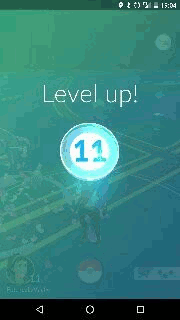
But therein lies the problem. In Ingress I can go to certain areas and gain 80 thousand or so points in a few minutes. Note that this is rare but possible. With Pokémon Go it is just a grind. There isn’t a way to get a lot of points at once, so once you hit the higher levels it starts to get dull. I made it to Level 27 and pretty much decided to quit trying to level, but did hit Level 28 through casual play. As with most gaming systems, the points required to level start to increase exponentially and so progress begins to slow as you advance. It also gets real frustrating when you need a particular ‘mon and can’t find it. With Ingress I’m in control of my destiny – I need to make links, I can go make links. In Pokémon Go the last ‘mon I needed was the Charizard, which is the fully evolved form of the Charmander. The problem is that they are rare in the areas I play. I needed 100 candy but only had 50. Luckily, Niantic added the ability to choose a ‘mon as your “buddy” and earn candy by walking. I had to walk nearly 70km to get the candy I needed. Andrea is even worse off since the ‘mon she is missing is the Aerodactyl, which I got by hatching an egg but we’ve never seen it in the wild. You can’t evolve one so her only hope of getting it is to get lucky with a 10K egg or stumble across one in the wild.
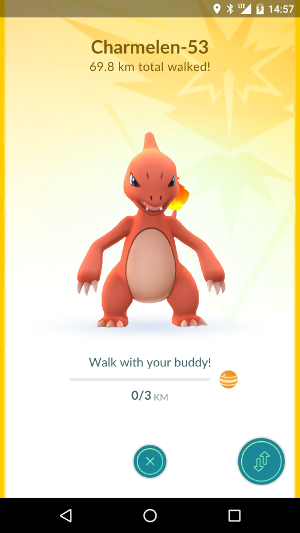
Which brings me to the main reason I like Ingress better than Pokémon Go. Ingress, warts and all, is inherently a social game. Portals can be up to level 8, but it takes two players to make a portal higher than 5, three to make one higher than 6 and a total of eight players to make a Level 8 portal. Doing a lot of the fun things in the game requires cooperation and coordination, and nothing illustrates this more than the “anomaly” events Niantic holds to bring Ingress players together. For example, we spent last weekend in New Orleans with a group of our friends playing the game at one such anomaly. The actual game play happened over five hours or so on Saturday, but we had a lot of fun the whole weekend hanging out and creating memories.
By contrast, Pokémon Go seems lonelier. While I play with Andrea (more than one person can attack a gym at the same time) only once have we managed to meet another player on our team and we forgot to come up with a way to meet up with him again. When the game came out, I started talking to the young people who were all excited about it, and a week later most of them had stopped playing because it “wasn’t fun”. If it could be made more of a social game perhaps that would help keep people interested.
Another thing that isn’t fun and that affects both games is GPS “spoofing”. It is somewhat easy to fool the games into thinking you are somewhere that you are not. When Pokémon Go started we had an issue with players trespassing at our office. We have security cameras that caught them in the act, but now more often than not when our gym changes teams no one actually bothered to come by – they just sat at home and spoofed their GPS. For Pokémon Go this lets you catch ‘mon that you might not otherwise see and to control more gyms, but in Ingress it has become extremely frustrating as a player may spend days setting up a portal in a remote location just to have a player for the other team take it out with little effort. When I was trying to get candy for my Charizard I was walking around town a lot. I stopped into the Chinese restaurant to grab lunch and the guy behind the counter saw my handy and that I was playing Pokémon. I looked at his phone and saw the same app, although his map looked totally different than mine. Turns out he was “in” San Francisco.
I’m not sure how Niantic can fully address the problem. While you can report abuse, with the success of Pokémon Go they don’t have the staff to manage that game much less pay attention to Ingress.
A few final notes, while the Ingress app is pretty stable, the Pokémon Go app needs some help. I have to restart it a couple of times an hour when playing, which just adds to the frustration. Plus, they have made it harder and harder to find pokémon, and the latest update requires you to travel at a relatively slow speed (seems to be around 8mph) in order to do anything. May be fine in a large city, but it sucks in rural towns.
So I won’t miss Pokémon Go. Andrea seems convinced I’ll pick it up when they release more generations of pokémon but I don’t think that will entice me. I’ve actually scaled way back on my Ingress play as well, but I still look forward to seeing my friends again at anomalies.
Overall, if you grew up playing Pokémon you’ll probably continue to play Pokémon Go, but for most non-fans the novelty wears off really fast.